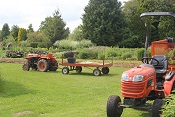
Improve your ability to manage the selection, operation and maintenance of tools and machinery, with particular reference to agriculture and horticulture. Farms, gardens, parks and plant nurseries are largely more productive today than ever before due to mechanisation.
Work that was previously done by many people can now be undertaken by one machine, but it is important to choose the right machine for the job, and use it appropriately.
Understanding machinery and equipment is pivotal to efficient and productive work output in modern horticulture and agriculture.
This course improves your ability to do the job and in turn enhances your prospects for career advancement or business profitability.